- Accueil
- À propos de nous
- Industrie
- Services
- Lecture
- Contactez-nous
Marché du tourisme d'aventure : Analyse actuelle et prévisions (2024-2032)
Accent mis sur le type (dur et doux) ; activité (terrestre, aquatique et aérienne) ; type de voyageurs (solo, couple, famille et groupe) ; mode de réservation (direct, agent de voyages et réservation via une plateforme) ; et région/pays
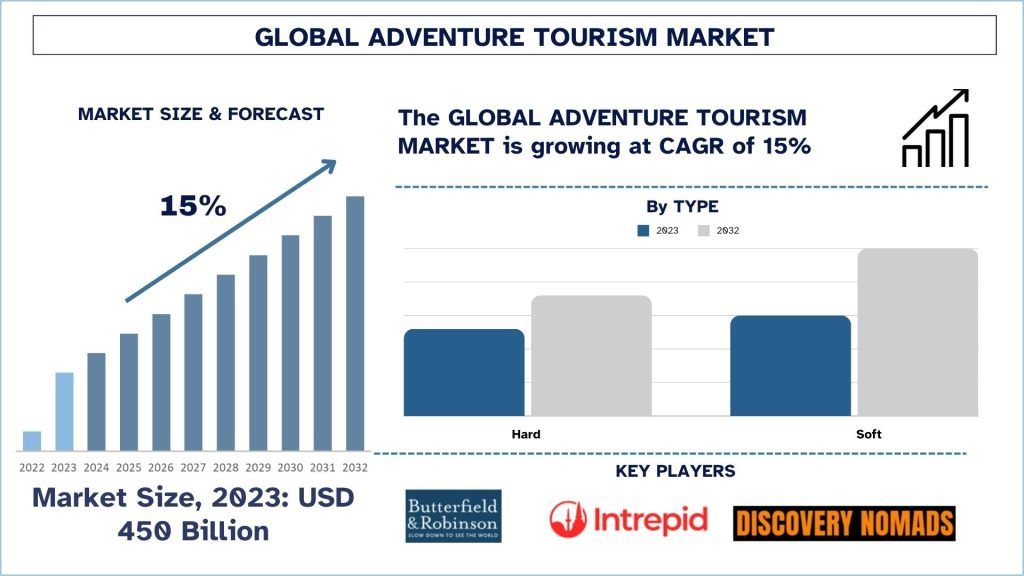 Taille et prévisions du marché du tourisme d'aventure
Taille et prévisions du marché du tourisme d'aventure
La valeur du marché du tourisme d'aventure était d'environ 450 milliards de dollars américains en 2023 et devrait croître à un TCAC important d'environ 15 % au cours de la période de prévision (2024-2032) en raison du nombre croissant de voyageurs dans le monde.
Analyse du marché du tourisme d'aventure
Le tourisme d'aventure s'adresse à un grand nombre de personnes directement et indirectement grâce aux opportunités d'emploi et aux infrastructures. Combiner l'efficacité de l'utilisation du tourisme comme moteur économique avec les préoccupations et la gestion de son impact sur l'environnement est important pour atteindre sa durabilité et son faible impact sur l'environnement dans ces domaines. Les collaborations entre entreprises, les acquisitions et les lancements de programmes innovants stimulent la croissance de l'industrie.
Par exemple, en juillet 2024, Mountain Travel Sobek a été désignée meilleure entreprise de voyage d'aventure n° 1 par Newsweek dans le cadre de ses prix annuels du choix des lecteurs. Cette distinction récompense le dévouement exceptionnel de MT Sobek à offrir des expériences de voyage extraordinaires et son engagement indéfectible envers la satisfaction de ses clients.
De plus, le sommet pré-Vibrant du tourisme du Gujarat, qui s'est tenu au Gujrat en décembre 2023, a annoncé qu'il se concentrerait sur le fait de faire de l'Inde l'une des meilleures destinations de tourisme d'aventure au monde.
Tendances du marché du tourisme d'aventure
Cette section examine les principales tendances du marché qui influencent les différents segments du marché du tourisme d'aventure, telles qu'identifiées par notre équipe d'experts en recherche.
Le segment des couples transforme l'industrie
La tendance du segment des couples pour le tourisme d'aventure a émergé plus radicalement au cours des dernières années en raison d'une préférence accrue pour les voyages romantiques et expérientiels. Une tendance majeure qui se dessine est la quête de nouveauté et de plaisir dans un environnement que les couples peuvent partager et s'amuser ensemble lors d'un voyage aventureux. Cela comprend la randonnée dans des zones obscures, les excursions d'observation de la faune, l'observation des créatures marines par la plongée et le snorkeling, et même la participation à des activités palpitantes comme la tyrolienne et le saut à l'élastique, entre autres. Cette tendance est due à un intérêt pour les expériences mémorables qui peuvent favoriser les liens, générer de nouveaux récits et accueillir des liens étroits dans le contexte d'un environnement magnifique. En réponse à la concurrence accrue, les voyagistes et les agences de voyage ont été contraints de proposer des gammes de produits d'aventure calibrées pour deux personnes, qui sont normalement associées à des hébergements de luxe, des guides privés et des repas intimes. La préférence pour les voyages qui permettent aux touristes de vivre des expériences intéressantes est en hausse et, de ce fait, le segment des couples dans le tourisme d'aventure devrait se développer davantage, ouvrant ainsi différentes possibilités pour les couples aventureux du monde entier.
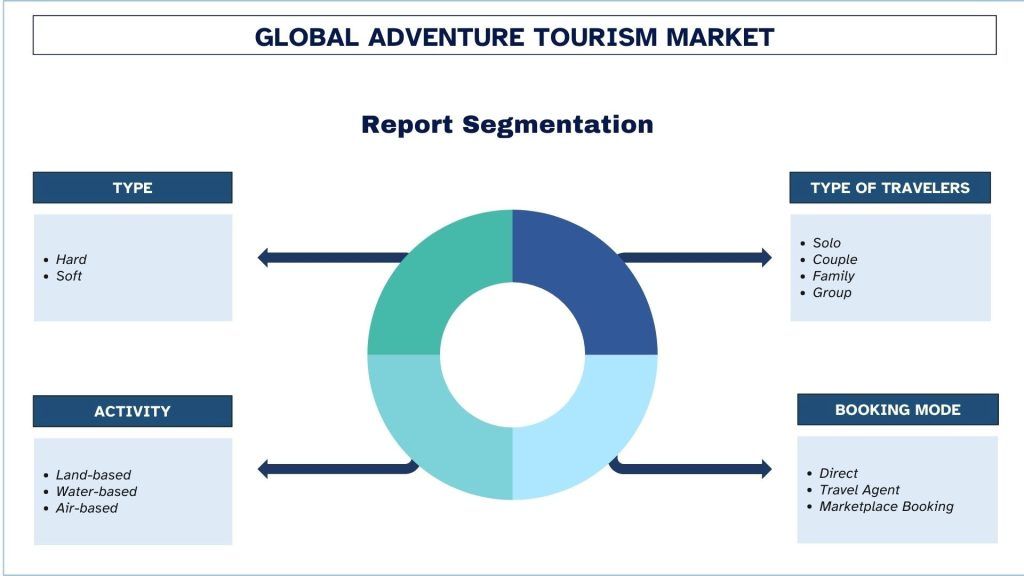
L'Amérique du Nord devrait croître à un rythme important au cours de la période de prévision.
Le tourisme d'aventure en Amérique du Nord est en croissance constante et est alimenté par plusieurs aspects. Des revenus disponibles plus élevés, une forte culture pour les activités de plein air et une tendance croissante à l'utilisation de l'expérience par les voyageurs nationaux et internationaux. Certaines des activités courantes comprennent la randonnée, le camping, la navigation de plaisance et l'observation de la faune, qui sont accréditées par le développement relatif de l'hébergement, du transport et d'autres services, ainsi que par la disponibilité de vastes étendues de terres naturelles, des parcs nationaux montagneux aux ceintures côtières. Les progrès continus dans le domaine du voyage d'aventure, ainsi que l'offre d'écolodges et la pratique d'un tourisme responsable, séduisent également le consommateur soucieux de l'environnement. Cette croissance du marché a non seulement été bénéfique pour les économies locales grâce au développement des recettes touristiques, mais elle a également contribué à la conservation et à l'échange de services culturels et à l'internationalisation du marché nord-américain en tant que marché international de premier plan pour les aventuriers du monde entier.
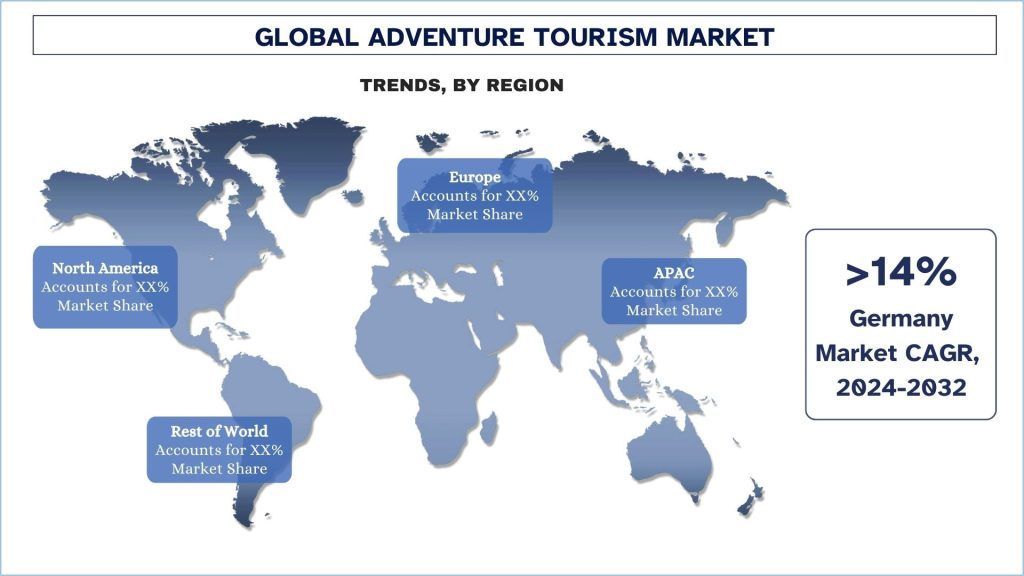
- En juillet 2024, Travel Corporation (TTC), basée aux États-Unis, et ses 18 marques leaders, dont Uniworld, Trafalgar et Contiki, ont été rachetées par la société américaine de capital-investissement Apollo pour un montant non divulgué.
- En octobre 2023, Heli Adventures, un opérateur de voyages d'aventure basé à Aspen, aux États-Unis, a acquis le célèbre domaine skiable de Silverton Mountain dans le Colorado, qui possède la plus haute altitude de ski des États-Unis.
Aperçu du secteur du tourisme d'aventure
Le marché du tourisme d'aventure est concurrentiel, avec plusieurs acteurs du marché mondial et international. Les principaux acteurs adoptent différentes stratégies de croissance pour améliorer leur présence sur le marché, telles que les partenariats, les accords, les collaborations, les expansions géographiques et les fusions et acquisitions. Parmi les principaux acteurs opérant sur le marché figurent Austin Adventures ; Butterfield & Robinson ; G Adventures ; GEOGRAPHIC EXPEDITIONS, INC. ; Intrepid Group Pty Limited ; Mountain Travel Sobek ; Discovery Nomads ; ROW Adventures ; TUI AG ; Cox & Kings.
- En avril 2024, Lindblad Expeditions Holdings, Inc., basée aux États-Unis, a acquis le groupe de voyages d'aventure primé Wineland-Thomson Adventures, Inc. par l'intermédiaire de sa filiale Natural Habitat, Inc.
- En janvier 2024, Travel + Leisure Co., basée aux États-Unis, a acquis l'activité de propriété de vacances du géant mondial de l'hôtellerie Accor pour 48,4 millions de dollars américains.
Couverture du rapport sur le marché du tourisme d'aventure
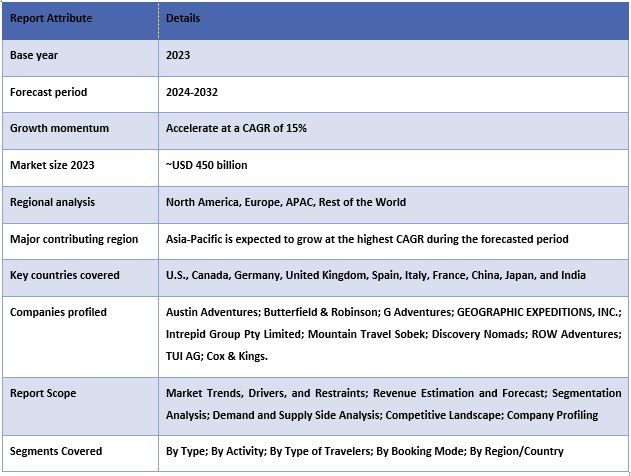
Raisons d'acheter ce rapport :
- L'étude comprend une analyse de la taille du marché et des prévisions validées par des experts authentifiés du secteur.
- Le rapport présente un aperçu rapide de la performance globale de l'industrie en un coup d'œil.
- Le rapport couvre une analyse approfondie des principaux acteurs de l'industrie, en mettant l'accent sur les principales données financières, les portefeuilles de produits, les stratégies d'expansion et les développements récents.
- Examen détaillé des moteurs, des contraintes, des principales tendances et des opportunités qui prévalent dans l'industrie.
- L'étude couvre de manière exhaustive le marché à travers différents segments.
- Analyse approfondie au niveau régional de l'industrie.
Options de personnalisation :
Le marché mondial du tourisme d'aventure peut être davantage personnalisé selon les besoins ou tout autre segment de marché. De plus, UMI comprend que vous pouvez avoir vos propres besoins commerciaux, n'hésitez donc pas à nous contacter pour obtenir un rapport qui correspond parfaitement à vos besoins.
Table des matières
Méthodologie de recherche pour l'analyse du marché du tourisme d'aventure (2024-2032)
L'analyse du marché historique, l'estimation du marché actuel et la prévision du marché futur du marché mondial du tourisme d'aventure ont été les trois principales étapes entreprises pour créer et analyser l'adoption du tourisme d'aventure dans les principales régions du monde. Une recherche secondaire exhaustive a été menée pour collecter les chiffres du marché historique et estimer la taille actuelle du marché. Deuxièmement, pour valider ces informations, de nombreux résultats et hypothèses ont été pris en considération. De plus, des entretiens primaires exhaustifs ont également été menés avec des experts de l'industrie à travers la chaîne de valeur du marché mondial du tourisme d'aventure. Après l'hypothèse et la validation des chiffres du marché par le biais d'entretiens primaires, nous avons utilisé une approche descendante/ascendante pour prévoir la taille complète du marché. Par la suite, des méthodes de ventilation du marché et de triangulation des données ont été adoptées pour estimer et analyser la taille du marché des segments et sous-segments de l'industrie concernée. La méthodologie détaillée est expliquée ci-dessous :
Analyse de la taille du marché historique
Étape 1 : Étude approfondie des sources secondaires :
Une étude secondaire détaillée a été menée pour obtenir la taille du marché historique du marché du tourisme d'aventure par le biais de sources internes à l'entreprise telles que les rapports annuels et les états financiers, les présentations de performance, les communiqués de presse, etc., et de sources externes, notamment les revues, les actualités et les articles, les publications gouvernementales, les publications des concurrents, les rapports sectoriels, les bases de données tierces et d'autres publications crédibles.
Étape 2 : Segmentation du marché :
Après avoir obtenu la taille du marché historique du marché du tourisme d'aventure, nous avons mené une analyse secondaire détaillée pour recueillir des informations et des parts de marché historiques pour différents segments et sous-segments pour les principales régions. Les principaux segments inclus dans le rapport sont le type, l'activité, le type de voyageurs, le mode de réservation et les régions. D'autres analyses au niveau des pays ont été menées pour évaluer l'adoption globale des modèles de test dans cette région.
Étape 3 : Analyse des facteurs :
Après avoir acquis la taille du marché historique des différents segments et sous-segments, nous avons mené une analyse des facteurs détaillée pour estimer la taille actuelle du marché du tourisme d'aventure. De plus, nous avons mené une analyse des facteurs à l'aide de variables dépendantes et indépendantes telles que le type, l'activité, le type de voyageurs, le mode de réservation et les régions du marché du tourisme d'aventure. Une analyse approfondie a été menée pour les scénarios de l'offre et de la demande en tenant compte des principaux partenariats, fusions et acquisitions, de l'expansion des activités et des lancements de produits dans le secteur du marché du tourisme d'aventure à travers le monde.
Estimation et prévision de la taille actuelle du marché
Évaluation de la taille actuelle du marché : Sur la base des informations exploitables tirées des 3 étapes ci-dessus, nous sommes parvenus à la taille actuelle du marché, aux principaux acteurs du marché mondial du tourisme d'aventure et aux parts de marché des segments. Tous les pourcentages requis de répartition des parts et les ventilations du marché ont été déterminés à l'aide de l'approche secondaire susmentionnée et ont été vérifiés par le biais d'entretiens primaires.
Estimation et prévisions : Pour l'estimation et la prévision du marché, des pondérations ont été attribuées à différents facteurs, notamment les moteurs et les tendances, les contraintes et les opportunités offertes aux parties prenantes. Après avoir analysé ces facteurs, des techniques de prévision pertinentes, c'est-à-dire l'approche descendante/ascendante, ont été appliquées pour parvenir à la prévision du marché pour 2032 pour différents segments et sous-segments à travers les principaux marchés du monde. La méthodologie de recherche adoptée pour estimer la taille du marché comprend :
- La taille du marché de l'industrie, en termes de revenus (USD) et le taux d'adoption du marché du tourisme d'aventure à travers les principaux marchés nationaux.
- Tous les pourcentages de parts, les répartitions et les ventilations des segments et sous-segments du marché.
- Les principaux acteurs du marché mondial du tourisme d'aventure en termes de produits offerts. De plus, les stratégies de croissance adoptées par ces acteurs pour être compétitifs sur le marché en pleine croissance.
Validation de la taille et de la part du marché
Recherche primaire : Des entretiens approfondis ont été menés avec les principaux leaders d'opinion (KOL), notamment les cadres supérieurs (CXO/VP, chef des ventes, chef du marketing, chef des opérations, chef régional, chef de pays, etc.) dans les principales régions. Les résultats de la recherche primaire ont ensuite été résumés et une analyse statistique a été effectuée pour prouver l'hypothèse énoncée. Les contributions de la recherche primaire ont été regroupées avec les résultats secondaires, transformant ainsi l'information en informations exploitables.
Répartition des participants primaires dans différentes régions
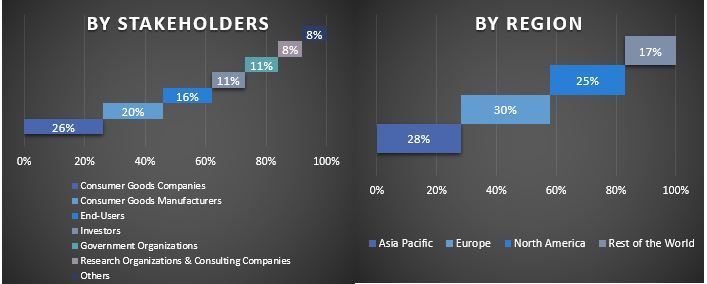
Ingénierie du marché
La technique de triangulation des données a été utilisée pour compléter l'estimation globale du marché et pour obtenir des chiffres statistiques précis pour chaque segment et sous-segment du marché mondial du tourisme d'aventure. Les données ont été divisées en plusieurs segments et sous-segments après avoir étudié divers paramètres et tendances dans les domaines du type, de l'activité, du type de voyageurs, du mode de réservation et des régions du marché mondial du tourisme d'aventure.
L'objectif principal de l'étude du marché mondial du tourisme d'aventure
Les tendances actuelles et futures du marché mondial du tourisme d'aventure ont été identifiées avec précision dans l'étude. Les investisseurs peuvent acquérir des connaissances stratégiques pour fonder leur pouvoir discrétionnaire en matière d'investissements sur l'analyse qualitative et quantitative effectuée dans l'étude. Les tendances actuelles et futures du marché ont déterminé l'attractivité globale du marché au niveau régional, offrant une plateforme aux participants industriels pour exploiter le marché inexploité afin de bénéficier d'un avantage de premier plan. Les autres objectifs quantitatifs des études comprennent :
- Analyser la taille actuelle et prévue du marché du tourisme d'aventure en termes de valeur (USD). De plus, analyser la taille actuelle et prévue du marché des différents segments et sous-segments.
- Les segments de l'étude comprennent les domaines du type, de l'activité, du type de voyageurs, du mode de réservation et des régions.
- Définir et analyser le cadre réglementaire du tourisme d'aventure
- Analyser la chaîne de valeur impliquée avec la présence de divers intermédiaires, tout en analysant les comportements des clients et des concurrents de l'industrie.
- Analyser la taille actuelle et prévue du marché du tourisme d'aventure pour la région principale.
- Les principaux pays des régions étudiées dans le rapport comprennent l'Asie-Pacifique, l'Europe, l'Amérique du Nord et le reste du monde.
- Les profils d'entreprise du marché du tourisme d'aventure et les stratégies de croissance adoptées par les acteurs du marché pour se maintenir sur le marché en croissance rapide.
- Analyse approfondie au niveau régional de l'industrie.
Questions Fréquemment Posées FAQ
Q1 : Quelle est la taille actuelle du marché du tourisme d'aventure et son potentiel de croissance ?
Q2 : Quels sont les principaux moteurs de la croissance du marché du tourisme d’aventure ?
Q3: Quel segment détient la part la plus importante du marché du tourisme d'aventure par type ?
Q4 : Quelles sont les technologies émergentes et les tendances du marché du tourisme d'aventure ?
Q5 : Quelle région dominera le marché du tourisme d'aventure ?
Connexes Rapports
Les clients qui ont acheté cet article ont également acheté










